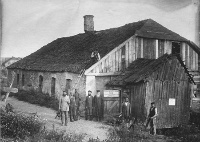
Also known as
Lubin or Labun'
Holocaust
| Home |
||||
| Location |
||||
| Gazetteer/History |
||||
|
||||
| Photographs |
||||
| Emigration |
||||
| Immigration |
||||
| Landsman |
||||
| Families |
||||
| Links |
||||
22 May 2011
|
||||||||||||||||||||||
|
By
5
July
1941,
Nazi
Germany
occupied
the
Khmelnitsky
Oblast
and
Labun'.
From
1941
to
1942
Jewish
people
in
the
shtetls
were
placed
in
ghettos,
starved,
and
tormented.
Most
were placed in a ghetto in a former rock
quarry in Polonnoye. At gun point
Jewish
residents were forced to desecrate their own cemeteries in Labun and
Polonnoye by rolling grave stones from one place to another.
Those who
were deemed uncooperative or caught trying to escape, were shot on the
spot. Periods of imprisonment,
starvation and torment were broken up by mass shootings on September
1941, 25 June 1942 and 10 September 1942. Some of these events
were
orchestrated and carried out by local accomplices of the Nazis. A few Jewish
residents escaped to
the
Soviet Union, Israel, the United States and other countries.
Others
escaped within Ukraine and Eastern Europe, hiding out with the help of
their non-Jewish neighbors until the war was over. Unfortunately,
not
all Ukrainians were as
courageous or righteous. By the time the Nazi's occupied this
area,
pursuit
of the "Final Solution" did not mean slow death at concentration camps,
but mass slaughter at gun point. The Jewish
populations
in many shtetls in this region vanished into burial trenches in a
matter of days. The few who remained were liberated by Soviet
troops on 4 January 1944. |
Polonnoye Yizkor Book
After World War II those who survived began an effort to recollect and preserve the shtetl life destroyed by the Nazi occupiers. In the 1950s and 1960s many Yizkor Books were produced for many localities. Today many are preserved in libraries and museums and, increasingly, online.While there is no Yizkor Book specifically for Labun, the one for Polonnoye includes many references to and recollections by former Labun Jewish residents. Portions of this book have been translated from Yiddish are are available on the Jewishgen website.
The book includes a list of those residents known to have perished during the occupation as well as several recollections and a short history of the area. Labun features prominently in the following sections:
- Memoirs of enslaved Maria Tibun from Polonnoye ghetto
- Memoirs of a former prisoner of a Jewish ghetto
- History of the Jews of Polonnoye for Five Centuries
- I will remember forever
- On the roads of war
- The difficult way
 To the top
To the top